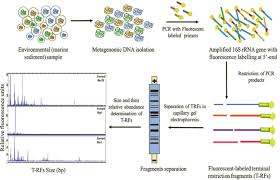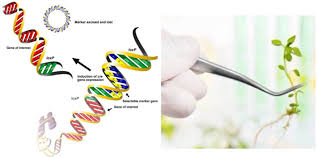Due to the rapid developments in the field of molecular genetics, a variety of different techniques have emerged to analyze genetic variation in the last few decades (Whitkus et al. 1994; Karp et al. 1996, 1997a,b; Parker et al. 1998; Schlötterer 2004).
These genetic markers differ with respect to important features such as genomic abundance, the level of polymorphism detected, locus specificity, reproducibility, technical requirements, and financial investment. No single marker is superior to all others for a wide range of applications.
The most appropriate genetic marker depends on the specific application, the presumed level of polymorphism, the presence of sufficient technical facilities and know-how, time constraints, and financial limitations.
A genetic marker is a gene or DNA sequence with a known location on a chromosome, associated with a particular gene or trait. It can be described as a variation that arises due to mutation or alteration in genomic loci, which can be observed.
A genetic marker may be a short DNA sequence, such as a sequence surrounding a single base-pair change (single nucleotide polymorphism, SNP), or a long one, like minisatellites.
For many years, gene mapping in most organisms was limited by traditional genetic markers, which include genes that encode easily observable characteristics, such as blood types or seed shapes. The insufficient amount of these types of characteristics in several organisms limited the mapping efforts that could be done.
Read Also: Different Systems of Rearing Rabbits
Commonly Used Types of Genetic Markers in Agriculture

Some commonly used types of genetic markers are:
1. RFLP (Restriction Fragment Length Polymorphism)
2. AFLP (Amplified Fragment Length Polymorphism)
3. RAPD (Random Amplification of Polymorphic DNA)
4. VNTR (Variable Number Tandem Repeat)
5. Microsatellite Polymorphism
6. SNP (Single Nucleotide Polymorphism)
7. STR (Short Tandem Repeat)
8. SFP (Single Feature Polymorphism)
9. DArT (Diversity Arrays Technology)
These markers can be further categorized as dominant or co-dominant. Dominant markers allow for analyzing many loci at one time, e.g., RAPD.
A primer amplifying a dominant marker could amplify many loci in one DNA sample with a single PCR reaction. Co-dominant markers analyze one locus at a time. A primer amplifying a co-dominant marker yields one targeted product.
Restriction Fragment Length Polymorphism (RFLP)
In molecular biology, the term restriction fragment length polymorphism, or RFLP, refers to a difference between two or more samples of homologous DNA molecules arising from differing locations of restriction sites, and to a related laboratory technique by which these segments can be distinguished.
In RFLP analysis, the DNA sample is broken into pieces (digested) by restriction enzymes, and the resulting restriction fragments are separated according to their lengths by gel electrophoresis.
Although largely obsolete today, RFLP analysis was the first DNA profiling technique cheap enough to see widespread application. Besides genetic fingerprinting, RFLP was an important tool in genome mapping, gene localization for genetic disorders, disease risk determination, and paternity testing.
Read Also: Reasons to use Rabbit Poo (Manure) for our Soil and Crops
Amplified Fragment Length Polymorphism (AFLP)

Amplified Fragment Length Polymorphism PCR (AFLP-PCR or simply AFLP) is a PCR-based tool used in genetics research, DNA fingerprinting, and genetic engineering. Developed in the early 1990s by Keygene, AFLP uses restriction enzymes to cut genomic DNA, followed by ligation of adaptors to the sticky ends of the restriction fragments.
A subset of the restriction fragments is then amplified using primers complementary to the adaptor and part of the restriction site fragments. The amplified fragments are visualized on denaturing polyacrylamide gels using autoradiography or fluorescence methods.
AFLP-PCR is a highly sensitive method for detecting polymorphisms in DNA. The technique was originally described by Vos and Zabeau in 1993. The procedure of AFLP involves three steps:
1. Digestion of total cellular DNA with restriction enzymes and ligation of restriction half-site specific adaptors to all restriction fragments.
2. Selective amplification of some of these fragments using two PCR primers that have corresponding adaptor and restriction site-specific sequences.
3. Electrophoretic separation of amplicons on a gel matrix, followed by visualization of the band pattern.
A variation on AFLP is cDNA-AFLP, which is used to quantify differences in gene expression levels.
Applications of AFLP in Agriculture
The AFLP technology can detect various polymorphisms in different genomic regions simultaneously. It is highly sensitive and reproducible. As a result, AFLP is widely used for the identification of genetic variation in strains or closely related species of plants, fungi, animals, and bacteria.
AFLP has been used in criminal and paternity tests, population genetics to determine slight differences within populations, and linkage studies to generate maps for quantitative trait locus (QTL) analysis.
AFLP offers several advantages over other marker technologies, including randomly amplified polymorphic DNA (RAPD), restriction fragment length polymorphism (RFLP), and microsatellites.
AFLP has higher reproducibility, resolution, and sensitivity at the whole-genome level compared to other techniques, and it can amplify between 50 and 100 fragments at once. Additionally, no prior sequence information is needed for amplification (Meudt & Clarke 2007).
This makes AFLP extremely beneficial in the study of taxa, including bacteria, fungi, and plants, where the genomic makeup of various organisms remains largely unknown.
Random Amplification of Polymorphic DNA (RAPD)
RAPD, which stands for Random Amplification of Polymorphic DNA, is a PCR reaction where DNA segments are amplified randomly.
The scientist performing RAPD creates several arbitrary, short primers (8-12 nucleotides), then proceeds with PCR using a large template of genomic DNA, hoping that fragments will amplify. By resolving the resulting patterns, a semi-unique profile can be created from a RAPD reaction.
No knowledge of the DNA sequence for the targeted gene is required, as the primers bind somewhere in the sequence, but it is not certain exactly where. This makes RAPD popular for comparing the DNA of biological systems that have not been studied extensively or systems where relatively few DNA sequences are compared.
However, it is not suitable for forming a DNA databank. RAPD has some limitations when using degraded DNA samples, and its resolving power is much lower than targeted, species-specific DNA comparison methods like short tandem repeats.
In recent years, RAPD has been used to characterize and trace the phylogeny of diverse plant and animal species.
Applications of Molecular Markers in Agriculture
Molecular techniques, particularly the use of molecular markers, have been utilized to scrutinize DNA sequence variation(s) in crop species and create new sources of genetic variation by introducing new and favorable traits from landraces and related crop species.
Markers aid in selecting for target alleles that are not easily assayed in individual plants, minimizing linkage drag around the target gene, and reducing the number of generations required to recover a high percentage of the recurrent parent genetic background.
Improvements in marker detection systems and the techniques used to identify markers linked to useful traits have enabled great advancements in recent years.
Although restriction fragment length polymorphism (RFLP) markers have been the basis for much of the work in crop plants, valuable markers have also been generated from random amplification polymorphic DNA (RAPD) and amplified fragment length polymorphism (AFLP).
Simple sequence repeats (SSR) or microsatellite markers have been developed more recently for major crop plants and are expected to lead to even more rapid advances in both marker development and implementation in breeding programs.
Identification of markers linked to useful traits has been based on complete linkage maps and bulked segregant analysis. However, alternative methods, such as constructing partial maps and combining pedigree and marker information, have also proved useful in identifying marker/trait associations.
Revising current breeding methods by incorporating molecular markers into breeding programs is crucial in modern agriculture.
Do you have any questions, suggestions, or contributions? If so, please feel free to use the comment box below to share your thoughts. We also encourage you to kindly share this information with others who might benefit from it. Since we can’t reach everyone at once, we truly appreciate your help in spreading the word. Thank you so much for your support and for sharing!

